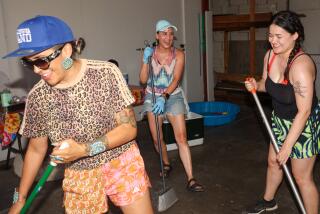Art Share Los Angeles boosts teens’ creativity
Janet Jackson’s fast-tempo track “If” blared over speakers as a handful of sweaty dancers moved in unison, their faces focused as they strained their legs to mimic the intricate moves of their instructor. Then the music stopped.
“You feeling the flexibility? You feeling the stretching? You want to feel it here,” the instructor said, standing in front of a massive mirror, motioning toward her upper thigh -- her leg extended perfectly straight in front of her.
Inside the brightly lighted theater that doubles as a studio in the arts district, these dancers are mostly teenagers. They could be out running the streets or hanging in malls, but instead they turn to dance or to another of the more than a dozen classes offered by Art Share Los Angeles.
The classes, which take place after school in downtown, don’t just offer kids a creative outlet or a place to kill time -- they provide the often at-risk teens a chance to flourish in an environment they’re not accustomed to.
“We have a lot of [success] stories here,” said Tracy Kelly, executive director of Art Share L.A., founded in 1997. “They get into art and something plugs in. People have no idea how art can change a life. It’s incredible.”
Kelly came to Art Share around 1999 and eventually became its program manager and ultimately executive director. Under her watch the center became the safe haven that it is today by crafting programs that cater to teens and young adults and to their families, while pushing for community involvement, which she says is critical.
Artful outlet
Although Art Share offers a variety of programs, its BLAST (Building Language and Art Skills Together) initiative is its foundation. Through the program, teens as young as 13 can enroll in the classes, which are offered in six-month sessions -- the next one begins in April.
Enrique Lopez Garcia, 18, started taking classes, including hip-hop, jazz and theater, two years ago after seeing a group of students perform at his high school. He said the classes provided an outlet that high school couldn’t offer.
“I like the whole family feel. You feel welcomed here, even if you are a beginner,” said the Boyle Heights High School student. “You can be yourself here. In high school it’s so structured, and to the textbook. I have more freedom here, more creativity. I have different ways of expressing myself.”
Kelly said the program is unique because it infuses language instruction with classes to help students improve their vocabulary and grammar, and at the same time it fosters self-expression and creativity, which they can utilize in the classroom.
Although the program is free for students, the operating costs weigh heavily over Kelly’s head.
“It takes $162,000 to operate two six-month sessions,” she said. But she forgot about the price tag or the thought of finding sponsors when one of her students walked into the gallery and embraced her.
“These are the moments I realize this is what I’m supposed to be doing,” Kelly said, “no matter how hard it gets. We make it happen with what we have.”
Kelly said funds come from donations from the public; fundraisers, including gallery sales and performances that typically showcase the students; and sponsors.
An extra push
Students who go through the program get an extra push from Kelly, who checks grades and homework -- she’s even made classroom visits to underperforming students. She said 92% of the students who come through the program graduate. And she wants to improve that.
Kelly said she realized early on that at-risk kids are often just misguided. She told a story of one of her first students, who belonged to a gang and hated African Americans. After she continuously challenged his views, he made a short film addressing racism in which he admitted he didn’t actually hate any race, he just wanted to blend into his environment.
“Kids are invisible these days. They have to be invisible to make it through the day,” Kelly said. “When they come here, they’re not invisible.”
Abel Castillo said he noticed a vast academic improvement when he started attending Art Share classes.
The 15-year-old from Boyle Heights said he started coming sporadically with friends to take a few salsa lessons and enjoyed the experience. A year later, he continues to take classes, including graffiti, photography and poetry. Good grades aside -- Kelly had to make one of those infamous classroom trips to visit the 10th-grader -- he’s found a boost of confidence.
“I’ve learned a lot here,” Castillo said. “One thing is . . . I have talent. Before, I didn’t think I was capable of anything.”
Danyol Jaye’s face was aglow as he walked around the 30,000-square-foot converted warehouse in the downtown arts district that Art Share calls home. In addition to the theater/studio, the two-story facility also houses gallery space, a computer lab, art studio, classrooms and residential lofts for low-income artists.
Like most of the young people who come through the door, Jaye, 24, says he arrived as a 17-year-old seeking refuge through music but chose to make his stay a little more permanent. After taking classes as a teenager, he began to volunteer, then accepted a part-time position, which became full-time. He also teaches an intermediate and advanced jazz dance class, resides in one of the lofts and performs regularly at program fundraisers.
Jaye, who doubles as the administrative assistant and event coordinator, said that above all, Art Share inspires hope that can’t be found in tough neighborhoods.
“I grew up in the ghetto. But when I see kids that are 15 and 16, I’m seeing them hugging -- you don’t see that in the hood,” Jaye said. “The hope that gets birthed here is just amazing. It’s really amazing to see, just the idea of art changing their lives. I’m thankful they have a place like this.”
More to Read
The biggest entertainment stories
Get our big stories about Hollywood, film, television, music, arts, culture and more right in your inbox as soon as they publish.
You may occasionally receive promotional content from the Los Angeles Times.











